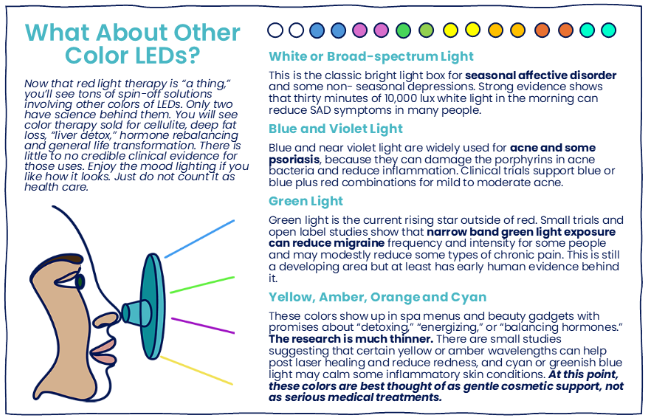
Red Light Therapy:
What It Does and What It Definitely Does Not Do
Red light therapy is being promoted everywhere. You can get it from your dermatologist or buy a device on Amazon. Red light therapy has become the wellness version of a Swiss Army knife. You can find it in facials, on TikTok, in “biohacking” spas, in hair helmets, and in full body panels that look like something from a sci-fi movie.
It is supposed to give you better skin, less pain, more hair, less fat, and possibly eternal youth if you believe the marketing.
Let’s dial that back and look at what the research actually says.
What Is Red Light Therapy, Really?
Most of what you see advertised as red light therapy is a form of “photobiomodulation,” also called low level light or low-level laser therapy. Devices use specific wavelengths of red and sometimes near infrared light, usually around 630 to 850 nanometers, at low power so they do not heat or burn the skin.
Your cells absorb this light in the mitochondria, the tiny “power plants” that make energy. The working theory is that a bit of extra energy can help cells repair damage, calm inflammation, and make more collagen or other helpful proteins. That sounds magical, but it is basic cell biology.
The important questions are not “does light hit the cells” but “does this meaningfully change a real-world problem in humans” and “how strong is the evidence.”
There are three areas where red light therapy is significantly supported by science: skin, inflammation, and hair loss.
Skin: Wrinkles, Texture, Wounds, and Acne
For skin, red light therapy is not complete fantasy.
Clinical studies of red and near infrared light on the face show improvements in fine lines, wrinkles, and skin roughness, along with increases in dermal collagen, compared with sham treatment. A randomized controlled trial of polychromatic red and near infrared light on the face found better skin texture and higher collagen density on ultrasound after a series of sessions.
Newer work with red and amber LEDs around the eyes reported about a 30 percent reduction in wrinkle volume after several weeks of treatment.
In real person terms, that means:
- It will not turn a seventy-year-old face into a twenty-five-year-old face.
- It can modestly smooth fine lines and help skin look a bit more even and “healthier,” especially when used as a series of office treatments or with a strong device.
For acne, the story is mixed. Blue and violet light kill acne bacteria more directly (see box). Red light appears to help mostly by calming inflammation and supporting healing. You are not going to cure deep cystic acne with a home mask, but red light can be one helpful part of a larger plan, especially for redness and healing after breakouts.
Red light has also been used in wound care, including slow-healing ulcers and radiation-or chemotherapy-related mouth sores, where it can speed healing and reduce pain in some studies.
Pain and Inflammation
This is the second area where there is real, if imperfect, evidence.
Systematic reviews of photobiomodulation for chronic musculoskeletal pain, including knee osteoarthritis, show that certain red and near infrared wavelengths can reduce pain scores and improve function more than sham treatment when the dose and wavelength are in the right range.
Randomized trials have also found benefit for conditions such as plantar fasciitis and some tendon problems when red or near infrared light is used as an addition to standard care like exercises and physical therapy.
The honest summary:
- Red and near infrared light can help with some kinds of chronic pain, especially joint and soft tissue pain.
- It is not a stand-alone cure. In successful trials it usually supplements, not replaces, regular care.
- Results are often modest and depend heavily on getting the wavelength, dose, and schedule right.
Hair Loss
Here, the evidence is better than many people expect.
Low-level laser and LED devices that emit red light over the scalp have FDA clearance for androgenetic alopecia. Multiple randomized trials and meta-analyses show improvements in hair density compared with sham devices for both men and women when used consistently over several months.
Think of it as a supportive therapy. It is not a miracle, and it tends to work best when combined with standard treatments such as minoxidil. It also requires patience and regular use.
Areas Where the Hype Is Way Ahead of the Evidence
The marketing for red light therapy is not shy. Here are some of the more ambitious claims, and where the science stands.
Weight Loss and “Body Contouring”
Red light is used in some “body sculpting” clinics that promise inch loss without effort. Studies show that after treatment, there can be a temporary reduction in circumference around the treated area, probably related to changes in water content and fat cell biology. It is not the same as true fat loss, and results tend to fade without lifestyle changes.
In other words, red light can tweak how tissue looks for a short time. It does not replace nutrition changes and movement. If a protocol promises dramatic weight loss while you lie on a table, you can safely be skeptical.
Dementia and Brain Health
Small early studies, including some using red and near infrared light on the head and even inside the nose, suggest possible improvements in sleep, behavior, and cognition in people with dementia.
The catch is that these studies are tiny, often without good control groups, and use highly specific devices. This is an interesting research area, not a clinically proven treatment you can recreate by sitting in front of a beauty panel at home.
Whole Body Anti-Aging and Longevity
You will see claims that a few minutes in front of a red-light panel “reboots your mitochondria,” fixes every cell in your body, and slows aging in general.
What we actually know is far more modest. Good quality evidence supports some skin benefits and some pain relief. There are intriguing but very early studies for other conditions. There is no large human trial showing that red light therapy extends lifespan or prevents age-related diseases in a meaningful way.
At this point, using it as a targeted tool for specific problems is reasonable. Treating it as a full body anti-aging solution is wishful thinking.
Is It Safe?
The good news is that red light therapy, at reasonable doses, appears to be quite safe. It does not involve ultraviolet light, so it does not raise skin cancer risk the way tanning does.
Side effects in studies are usually mild. At high settings you can see temporary redness or irritation, and very rarely blistering. Eyes are more vulnerable, so protective goggles are important, especially with high-power panels or lasers.
People who take medications that increase light sensitivity or who have a history of skin cancer, eye disease, or certain autoimmune conditions should talk with a dermatologist or other clinician before using light devices.
There is still limited information on very long-term, frequent use in healthy people, so “more is better” is not a good idea here.

At-Home Devices Versus In-Office Treatments
In-office devices are more powerful and are usually used under more standardized protocols. That is part of why studies tend to find clearer benefits in clinical settings for skin and pain problems.
Home masks, wands, and panels can still be useful, but expectations should be realistic. Effects are usually subtle and depend on consistent use over many weeks. If you are buying a device, look for:
- A manufacturer that provides clear information on wavelength and power, not just claims.
- Safety certifications or FDA clearance where applicable.
- Eye protection and clear instructions on distance and session time.
If the marketing sounds like a miracle, it is safer to assume you are buying an expensive night light.
How To Decide If It Is Worth Trying
If you are curious about red light therapy, a few questions can help you think it through.
- Do you have a specific goal that has some evidence behind it, such as mild wrinkles, acne, a chronic joint or tendon problem, or androgenetic hair loss?
- Is there a clinician involved who can confirm your diagnosis and help set expectations?
- Can you comfortably afford the time and money, knowing that benefits are likely to be modest and slow?
If all of that is a yes, it can be reasonable to use red light as one tool among many. If you are hoping it will replace sunscreen, exercise, medication, or a good night’s sleep, it is not that tool.